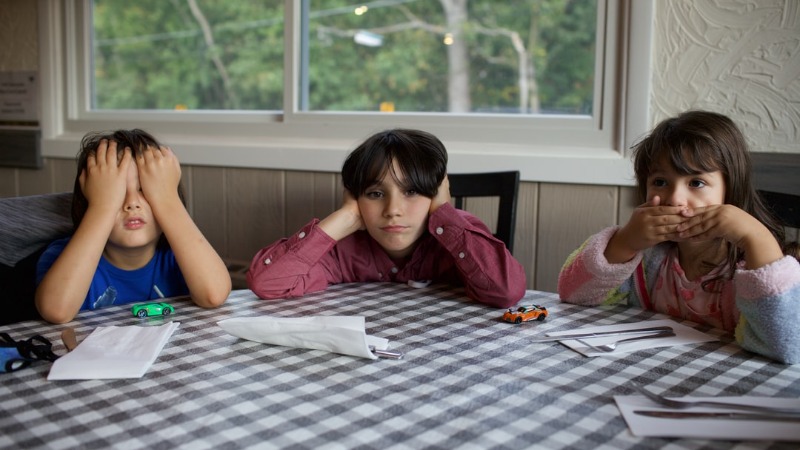Children have the beautiful skill of tapping into and expressing their emotions, but face challenges when it comes to effectively and peacefully processing these emotions — even the fun ones!
My sister, who is a kindergarten teacher, was recently brainstorming activities that can enhance emotional intelligence and communication in children, especially when they’re dealing with stress or conflict.
As a certified hypnotherapist, who primarily works with pregnant women and children, I jumped in to add my ideas on how to best guide these fresh and vulnerable minds (and hearts!) through the journey of understanding and communicating their emotions, that often change every few minutes (much like pregnant women!).
Here are our favorite exercises to raise emotionally intelligent kids …
1. Physical Mirroring
So often, children express their emotions through their bodies. (Ever seen a toddler fling himself on the floor in a fit of rage?)
Have your child stand in front of you (or the child they are having a conflict with) and express their emotions through physical actions — without speaking, harming themselves, or touching the other person. Have the other party mirror the actions. This activity helps the child tune in to how their body is processing their emotions, and helps the other party empathize with the emotions by partaking in the physical release. This builds understanding and trust.
2. Speech Mirroring
If your child is having difficulty communicating their emotions, have them start this activity by saying how they feel, or how they think they feel. You then repeat the sentence back to them.
For example, your child might say:
“I think I’m feeling sad that my friends are not playing with me as much as they used to.”
And then you would respond with:
“I’m hearing you say that your friends aren’t playing with you as much as they used to.”
Continue on with this pattern until your child begins to verbalize solutions to their struggles.
This activity may feel unnatural in the beginning, but will help your child feel heard and understood, creating the space for them to process, and potentially solve, their challenges without you having to give advice.
3. Nonviolent Communication
Nonviolent communication focuses on communicating with full compassion, without violence in the heart. It is the practice of freeing judgments from your interactions with others and not telling someone how they should feel, or what they should be doing. In it’s simplest form, nonviolent communication follows the pattern of Observation-Feeling-Need-Request.
For example, a child wanting to communicate his frustration about going to bed could say the following:
- Observation: “I hear that you are asking me to go to bed.”
- Feeling: “I feel frustrated with the idea of going to bed because I’m not tired, and I’m enjoying the book I’m reading.”
- Need: “I’m needing to feel like I can help make decisions about my schedule.”
- Request: “Would you agree to let me stay up for 15 more minutes?”
(When you’re teaching the “Request” step, let them know that “no” may be an answer they’ll receive, meaning they will need to continue the conversation, expressing their observations, feelings, needs, and requests in a nonviolent manner.)
Make sure you’re following this same pattern when talking to your child. While this technique may be difficult for your child to use when speaking with someone who is not familiar with the steps, the learning you do together, within your own family, will build their awareness and skill for communicating from a space of compassion.
Much like speech mirroring, this may feel forced and inorganic at first, but with practice it will shift the source of your communication from the ego to the heart.
4. Conflict Resolution Through Handwritten Letters
If your child is stuck in a difficult situation with you, another family member, or a friend, have them write a handwritten letter expressing all their feelings. If they’re not able to write, help them create the letter. When the letter is complete, have them rip it into tiny shreds and throw it away. Or, you could help them burn it in a safe and supervised manner.
5. Mind Movie Meditation
When children become overwhelmed with the (good or bad) potentials of a future situation, the resulting overload of emotion can express itself in hyperactivity, nerves, sadness, or many other forms of feelings that are difficult for children to manage. When your child is nearing an experience they have strong feelings about, have them lay in a comfortable position, close their eyes, take deep-in-the-belly breaths, and imagine the upcoming experience like it was a movie. Tell them to see the events of this experience exactly as they want them to go, while feeling all the positive emotions associated with these favorable outcomes.
6. Silent Eye Contact and Smiling
Sometimes children just need a quiet and kind moment. Set a timer for one minute, sit across from one another, look into each other’s eyes, and just smile until the timer goes off — no talking. (And yes, you can blink.) This activity will often morph into laughter, which will diffuse even the heaviest of situations. This is also an excellent activity for children to do together, while in an argument.
7. Intentional Laughing
Similar to silent eye contact and smiling, the practice of intentional laughter is sure to disperse tense situations. Stand in front of your child and do a simple laugh. “Ha ha ha!” works. Then, have them repeat the laugh. Continue with this pattern of laugh and repeat until you’re both rolling with authentic laughter.
***
One of the best ways to infuse these practices into your child’s life is to lead by example. Practice these communication techniques with your partner, and slowly present them as options to your child, allowing them to select the strategies that feel best to them.
And if in doubt, just give your kiddo a big hug!






